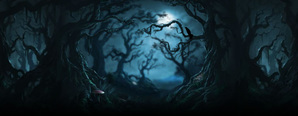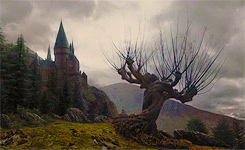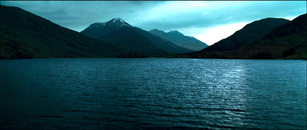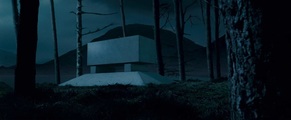Castle Grounds
All the protective charms that we discussed in the introduction lesson are not only shielding the castle but the surrounding grounds as well. This is of high importance because the grounds are used for entertainment, sports, and even education (for classes such as Herbology, Broom Flying, and Care of Magical Creatures). We already mentioned several notable places at the grounds, but here we will have a closer look at all of them.
 The Forbidden Forest
The Forbidden Forest
The Forest is rather close to the castle, bordering the grounds on the east side. You can also find it referred to as the Dark Forest (or even the Black Forest), but it eventually took this name because it was always strictly forbidden to go there, especially with no chaperone from the staff members. The only times when going inside is allowed is during Care of Magical Creatures classes (usually taking place at the very entrance though, never deeper), or when the student earned himself/herself detention.
But the Hogwarts Staff do not have to go above and beyond to keep students out of the forest — with all the dangerous creatures that inhabit it, few would have the courage to enter. It's likely that if some ever do, they'll quickly reconsider their decision once they see what horrors inhabit the forest. If you're wondering what these horrifying creatures are, I've provided a scary list for you:
- A whole colony of Acromantulas (giant spiders with a XXXXX M.O.M. Classification and a special taste for human flesh) dating from the early 1940s, probably 1943;
- A colony of Centaurs (half-human, half-horse, a very cunning but also defensive breed with a XXXX Classification);
- Herds of Unicorns (an XXXX equine creature with a pure white color and a single horn on its head — parts of it are highly valuable in the Wizarding World);
- Herds of Thestrals (a XXXX winged horse with a skeletal body that can be seen only by those who have witnessed someone dying);
- Herds of Hippogriffs (a half-eagle, half-horse XXX creature which is extremely proud and easily offended);
- Colonies of Blood-Sucking Bugbears (apparently some type of furry bugs that suck blood from living beings);
- Immense amount of Bowtruckles (XX creatures that look like tree planks, but they can be dangerous while serving as tree keepers);
- There are also a number of creatures which are believed to live there, but they haven't been sighted (yet). Some examples are trolls, werewolves, giants, vampires and hags. If you ever go there (which you totally shouldn't!) and see any of those creatures, you will be the first one to confirm their presence in the forest. That is, if you live to tell the tale.
 Cabin of the Keeper of the Keys
Cabin of the Keeper of the Keys
This small wooden cabin is located right on the edge of the Forbidden Forest, and it serves as a home for the Hogwarts Gamekeeper and Keeper of the Keys (usually the same person). It is actually a single room with a few windows, and the furniture inside is rather simplistic. There is a huge bed with patchwork quilt, a small fireplace used both for warmth and cooking, a tiny wooden table surrounded by a few chairs, and a cupboard for storing food, herbs, and various other miscellaneous. Ironically, the cabin is large enough for the half-giant Rubeus Hagrid to live in it together with his pet dog, Fang, and many other personal belongings. This implies that the cabin is quite large, or otherwise it has some magical enchantments, like the ones Hogwarts has, to let it change its size by will and need.
Behind the cabin, there are small pumpkin patches that he takes care of, and it is said those pumpkins are extremely huge, so big that everyone says they've never seen anything like that before. A wooden fence protects the patches from outsiders.
 Quidditch Pitch
Quidditch Pitch
As we mentioned in the first lesson, this is the place where the school's most popular sport is played — Quidditch. The pitch has an oval shape, it is 500 feet long and 180 feet wide, with a small circle in the center with a diameter of about 2 feet where all the balls are released from at the start of each game. On each end there are three Goal Posts with hoops, the chasers during a game need to shoot through them order to score and earn their team 10 points. The whole pitch is surrounded by a small wooden wall covered with benches for sitting and very high tower stands which change their color for every match (every second stand has the colors of one of the teams, while every other stand has the colors of the opposing team).
The spectators can obviously sit on the benches between the stands, and cheer for their house's quidditch team. The benches are actually placed at the highest point of the wall, but this is made on purpose because Quidditch is an aerial sport (broom flying) and the spectators need to be high as well if they want to follow the matches more clearly. During the official quidditch season there are about 6 inter-house matches, and a huge number of practices/training sessions by each house's team. On top of that, many other events take place on the pitch too, though it is usually modified to be more fitting for the event. Because of this, you can rarely find the pitch not being busy.
 Greenhouses
Greenhouses
There are several greenhouses on the east side of the castle, most of which are used for the Herbology classes or for providing plants used in the Potions classes. The greenhouse go by number and as the number increases (Greenhouse 1, Greenhouse 2, etc.) the size of the greenhouse increases, as well as the level of danger and value of the plants that are present in there. There are also massive dragon statues that run along the peaked roofs of the greenhouses. At times, when the Potions classroom isn't available for classes, or when someone wants to practice Potions, they use the Greenhouses. Presumably, in one of the greenhouses there is an office which has a similar interior to the Gamekeeper's cabin, and it is used by the Herbology Professor for working and sleeping during their stay at Hogwarts.
Vegetable Patches
Behind the Greenhouses there are many patches where different types of vegetables are grown by the Herbology Professor, the Potions Professor, and the Gamekeeper, all of which need certain plants for teaching purposes. We know that cabbages and pumpkins were once growing there, but we don't know for sure all the types of vegetables that have grown.
Training Grounds
Another thing very close to the Herbology Greenhouses are a few clear and smooth lawns, used by the first year students for their Flying classes. The Gamekeeper takes care of the training grounds, and he makes sure the ground is flat and the grass short-cut, so there are no obstacles for the classes held on these areas. Furthermore, because the training grounds are open, huge, and obviously with smooth surface, they are used for various other training purposes, from potions practice to dueling sessions.
 Whomping Willow
Whomping Willow
Although this magical species of trees is very dangerous, as it has self-conscience and can think for itself, it is of great value and importance and it is forbidden to damage or hurt it in anyway. It is endemic to Scotland and the Forest of Dean in England, but it is extremely rare so it is considered almost extinct. As you can see from the name, it's related to the Willow deciduous species of trees, though this one is much bigger than any of them. Whenever someone gets in their range, it will attack the person with their branches until they get rid of them, which makes the tree a perfect guardian for any location. Its limbs act as its arms, and all damage inflicted to them must be treated with great care.
Hogwarts also has one of these, and it was planted in a triangle between the Forbidden Forest, the Herbology Greenhouses, and the Gamekeeper's Cabin, around 1971. The purpose of the Whomping Willow was to guard a secret passageway that goes underneath it and leads to the Shrieking Shack (an abandoned, spooky house) in Hogsmeade. There are two possible ways to immobilize the tree and enter this passageway — using the spell "Immobulus", or pressing a specific knot at the base of the three (I'm not really sure which one is the right one, I always use the spell because it's much easier and less risky). Don't tell the other staff members I told you this!
 Black Lake
Black Lake
The castle actually lies at the edge of the Hogwarts Lake, and the rest of this huge body of water lies south of the castle. Its diameter is about half a mile, and it is inhabited by various different creatures. These include:
- A big colony of Merpeople (XXXX creatures which can speak and breathe underwater, and look like a half-fish and half-human breed even though they are completely new species and not actually half-breeds);
- Many Grindylows (XX horned water demons which are usually domesticated by Merpeople and kept as pets);
- A Giant Squid (an enormous semi-sentient squid with many tentacles that helps students cross the lake or simply help them out when they end up in trouble around it — obviously not dangerous).
Since the castle is placed at the edge of the lake, certain rooms from the lower part of the castle end up beneath the level of the lake (for example Slytherin's Common Room, various parts of the Dungeons, etc.). The water of the lake is very cold, which is probably why the sub-levels of the castle are never really warm. Though, certain students are known to have swum in it, especially when there is need to do so like when an event such as a task for the Triwizard Tournament takes place there.
 White Tomb
White Tomb
On the shores of the Black Lake lies a white tomb, the one and only grave that has ever been placed on the castle's grounds. It is the final resting place for Albus Percival Wulfric Brian Dumbledore, the beloved Transfiguration Professor who was Headmaster of Hogwarts from 1953 to his death in 1997 (with a few gaps in that time span, due to changes of the school's situation). This recipient of the "Order of Merlin — First Class" award was aged 115 when he passed away, and his death was a great loss for the Wizarding World. He had many important contributions, such as the defeat of Gellert Grindelwald (one of the greatest Dark Wizards of all times, second only to Tom Riddle who is also known as Voldemort), the discovery of the twelve uses of dragon's blood, his collaborative work on alchemy with Nicholas Flamel (the creator of the Philosopher's Stone), and his brilliant work against Voldemort with the resistance group — the Order of the Phoenix.
Dumbledore was also the wielder and master of the Elder Wand, one of the Deathly Hallows, from 1945 till the 30th of June, 1997, when he faced a slow death from the curse of Marvolo Gaunt's Ring, one of Voldemort's Horcruxes. However, the final blow that finished him was a killing curse by Severus Snape which threw him off of the Astronomy Tower. He is considered the greatest wizard who has ever graced Hogwarts as a Headmaster, especially because it's under his planning and influence that Voldemort was brought to his end and peace was restored to the Wizarding World. His portrait still remains in the Headmaster's Office in Hogwarts.
That's all for this lesson! We've already covered everything you need to know about the castle's grounds so you can proceed to working on the assignment now!